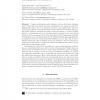Free Online Productivity Tools
i2Speak
i2Symbol
i2OCR
iTex2Img
iWeb2Print
iWeb2Shot
i2Type
iPdf2Split
iPdf2Merge
i2Bopomofo
i2Arabic
i2Style
i2Image
i2PDF
iLatex2Rtf
Sci2ools
98
Voted
MTA
2007
2007
Flexible integration of multimedia sub-queries with qualitative preferences
Complex multimedia queries, aiming to retrieve from large databases those objects that best match the query specification, are usually processed by splitting them into a set of m simpler sub-queries, each dealing with only some of the query features. To determine which are the overall best-matching objects, a rule is then needed to integrate the results of such sub-queries, i.e., how to globally rank the m-dimensional vectors of matching degrees, or partial scores, that objects obtain on the m sub-queries. It is a fact that state-of-the-art approaches all adopt as integration rule a scoring function, such as weighted average, that aggregates the m partial scores into an overall (numerical) similarity score, so that objects can be linearly ordered and only the highest scored ones returned to the user. This choice however forces the system to compromise between the different sub-queries and can easily lead to miss relevant results. In this paper we explore the potentialities of a more ...
Related Content
| Added | 27 Dec 2010 |
| Updated | 27 Dec 2010 |
| Type | Journal |
| Year | 2007 |
| Where | MTA |
| Authors | Ilaria Bartolini, Paolo Ciaccia, Vincent Oria, M. Tamer Özsu |
Comments (0)

